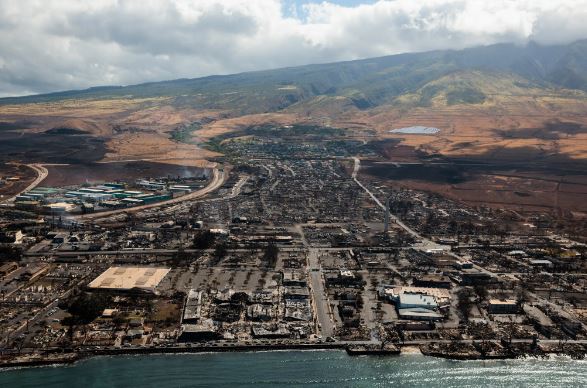A federal investigation has confirmed that the deadly wildfire that devastated the Hawaiian town of Lahaina last year reignited from a brush fire that firefighters had initially believed to have been fully contained and extinguished. The fire, which became one of the deadliest in U.S. history, claimed more than 100 lives on the island of Maui.
In a report released Wednesday, investigators from the Bureau of Alcohol, Tobacco, Firearms, and Explosives (A.T.F.) and the Maui County Department of Fire and Public Safety concluded that embers from the original fire, triggered by downed power lines, rekindled and spread into residential neighborhoods. This determination confirms suspicions voiced by residents who had long believed the flames that consumed Lahaina reignited in the same area where firefighters had been battling a morning blaze.
Despite this conclusion, local officials had previously left open the possibility that another factor may have sparked the fire that swept through Lahaina. The new report, however, definitively points to the original fire as the source, concluding it had never been fully extinguished and was able to reignite under strong winds.
Maui’s fire chief, Brad Ventura, acknowledged the tragedy of the fire rekindling but expressed confidence in the actions of the firefighters who responded to the initial blaze. Speaking at a news conference, he said, “A rekindled fire is something that nobody wants to see happen.” However, he reiterated that fire crews on the scene acted appropriately based on the conditions at the time.
The report traces the initial fire back to August 8, when high winds caused power lines to snap, sparking a blaze that first erupted in the early morning. Fire crews arrived promptly at 6:40 a.m. and fought to contain the fire, which had been ignited by the re-energization of the damaged power lines. Firefighters worked throughout the morning and remained on-site for over five hours after the flames appeared to have been suppressed.
To ensure the area was secure, crews used heavy machinery to create firebreaks, intended to prevent any possible spread. According to local officials, by early afternoon there were no visible flames, smoke, or glowing embers, leading the last fire crews to depart the scene at 2:18 p.m. to return to their station for a break.
However, just minutes later, the fire reignited and began spreading rapidly, engulfing homes and turning into an inferno that residents struggled to escape. The heavy winds fanned the flames and contributed to the rapid escalation of the situation.
Jeff Giesea, the assistant fire chief of Maui County, provided several theories as to how embers from the initial fire could have gone undetected. He suggested that a piece of burning material may have been buried under dirt or ash, only to be uncovered and reignited by the strong winds. Additionally, the machinery used to create the firebreaks could have inadvertently pushed smoldering material into an area with fresh fuel, allowing the fire to grow again.
Jonathan Blais, the special agent in charge of the A.T.F. division overseeing the investigation, emphasized that fire crews had dedicated significant time and resources to managing the initial blaze. Nonetheless, the rekindling of the fire led to the deadliest wildfire in the United States in the past century.
As the fire spread, the chaos worsened. Downed power lines blocked key escape routes, cell phone coverage faltered, and evacuation warnings were delayed. Even fire hydrants failed as water supplies ran dry, adding to the devastation and loss of life.
The report is part of a broader investigation into multiple failures in both the preparedness and response to the fire. The findings have highlighted inadequacies in managing the dry vegetation that contributed to the spread of the fire, poor coordination among various officials, and a lack of planning for dangerous weather conditions like the high winds that stoked the flames.
While the investigation found no grounds for criminal charges, Hawaiian Electric, the utility company responsible for the power lines, has agreed to pay the largest share of a $4 billion legal settlement. The company has also begun implementing pre-emptive power shut-offs in areas at high risk of wildfire to prevent future disasters.
In response to the fire, state and local officials have undertaken new efforts to manage dry vegetation and improve wildfire preparedness. However, more than a year after the tragedy, the future of Lahaina remains uncertain. While debris has been cleared from many properties, Maui officials are still in the process of developing a plan for rebuilding the town. Discussions have focused on moving residents to new neighborhoods, restoring historic wetlands, and resolving community divisions over how to rebuild the beloved waterfront that once drew tourists to shop and dine.
As Maui looks toward recovery, the scars of the wildfire will remain, but efforts to rebuild a safer, more resilient community continue.

